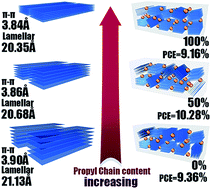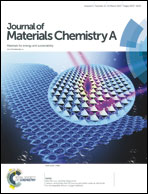Fine-tuning solid state packing and significantly improving photovoltaic performance of conjugated polymers through side chain engineering via random polymerization†
Abstract
Alkyl chain engineering has been employed to tune the physicochemical properties of conjugated polymers. Usually, several building blocks with different alkyl chains need to be synthesized in multiple steps, which is synthetically costly. Also, it is challenging to systematically tune the alkyl chains to enhance device performances due to the complex morphological characteristics of the conjugated polymers and the effects of molecular weight and purity. Here we designed and synthesized a series of conjugated polymers with similar molecular weights through random polymerization of BDT building blocks with two TT building blocks possessing different alkyl chains. Upon simply altering the molecular ratio of two TT units, the physicochemical characteristics, solid state packing, and photovoltaic properties of the conjugated polymers were systematically tuned. As a result, a conjugated polymer that can pair with both fullerene (PC71BM) and non-fullerene (ITIC-Th) acceptors to generate high power conversion efficiencies (10.3% and 9.1%, respectively) was achieved. This contribution provides a novel strategy for designing high performance conjugated polymers.



 Please wait while we load your content...
Please wait while we load your content...